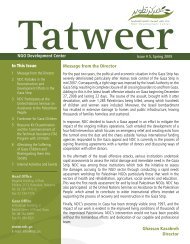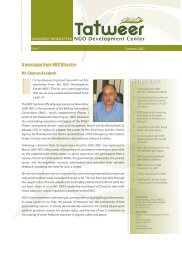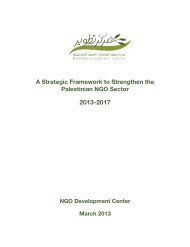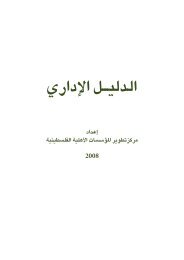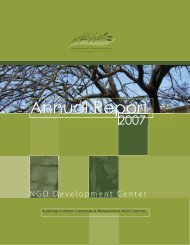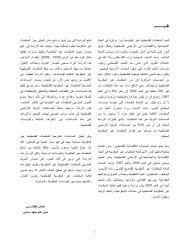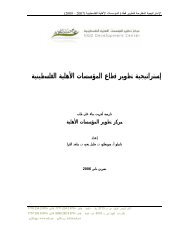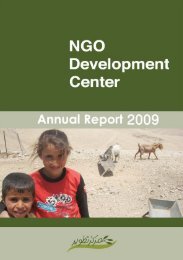Tracking External Donor Funding.pdf - NDC
Tracking External Donor Funding.pdf - NDC
Tracking External Donor Funding.pdf - NDC
You also want an ePaper? Increase the reach of your titles
YUMPU automatically turns print PDFs into web optimized ePapers that Google loves.
In the Central West Bank, Ramallah and Bireh are<br />
home to over 130 PNGOs who have almost doubled<br />
their reliance upon international aid between 1999 and<br />
2006, from 37% to over 71%. In Jerusalem, both the<br />
number of PNGOs and their percentage of reliance on<br />
external aid decreased. Jericho, the least active<br />
governorate in terms of PNGO activity and external<br />
aid, moves from 9 to 17 PNGOs between 1999 and<br />
2006, while the dependence of these organizations<br />
remained steady around 8% of their total budgets.<br />
In the Southern West Bank, both Hebron and<br />
Bethlehem have seen an increase their number of<br />
PNGOs, as well as increased the dependence of these<br />
organizations on external aid. However, reliance on<br />
external aid is much higher in Bethlehem (63.3%) than<br />
in Hebron (35.6%) and has increased more<br />
dramatically between 1999 and 2006.<br />
In the Gaza Strip, the number of PNGOs increased<br />
dramatically throughout all of the governorates<br />
between 1999 and 2006. Furthermore, all of the<br />
PNGOs operating in the Strip derive at least half of<br />
their budgets from external donors. In Khan Younis<br />
and Rafah, the dependence on external donors is the<br />
highest in the WB&GS at over 80%.<br />
3.8.3 Geographic Distribution of <strong>External</strong> <strong>Donor</strong><br />
HQs in the WB&GS<br />
The location of the HQs of external donors was<br />
gathered through a mapping of ten years of PASSIA<br />
Directories 42 . <strong>External</strong> NGOs and Governmental<br />
donors are located overwhelmingly in the Central West<br />
Bank, in Ramallah and Jerusalem, with no presence in<br />
Jericho. According to our sample, nearly 84.5% of<br />
International agency HQs are in the Central West<br />
Bank, as opposed to only 5.6% in the North, 5.3% in<br />
the South and 4.6% in the Gaza Strip (see appendix for<br />
full 10 year statistical layout). On a regional basis, this<br />
remains virtually unchanged over the 10 year period.<br />
represent the political centers of Israelis and<br />
Palestinians. As such, international agencies gravitate<br />
to where the decision makers are. Though this is<br />
natural in the case of Governmental donors, the same<br />
holds true for INGO ones as well.<br />
The concentration of international agencies in the<br />
Central West Bank raises interesting questions<br />
concerning PNGO access to external aid.<br />
<br />
Can these agencies be accessed as easily by<br />
PNGOs located outside of these cities and<br />
surrounded by a series of checkpoints and<br />
obstacles; or are the more ‘cosmopolitan’ elite<br />
urban PNGOs in Ramallah and Jerusalem given<br />
an advantage by their proximity to donors<br />
In 2006, PNGOs with HQs in Ramallah and Bireh<br />
received 71.4% of their funding from external sources.<br />
This is in stark contrast to more marginalized cities in<br />
the Northern or Southern West Bank. PNGOs located<br />
in Hebron, for example, receive only 35.6% of their<br />
funding from abroad; while those located in Tulkarm<br />
receive only 20.2% 44 . It should be noted that the<br />
percentage of funding from external sources of PNGOs<br />
in Ramallah and Bireh has nearly doubled since 1999<br />
(MAS, 2007:76-77).<br />
<br />
Secondly, do donors prefer to work with NGOs in<br />
the Central West Bank due to the much greater<br />
freedom of movement and access they enjoy in the<br />
region that makes oversight easier and more<br />
efficient<br />
As you will see below, 69.6% of external aid<br />
partnerships are made with PNGO headquartered in the<br />
Central West Bank. According to our previous<br />
mappings, PNGOs working at the national and seminational<br />
levels are also overwhelmingly located in<br />
either Ramallah or Jerusalem.<br />
In Palestine, where projects and programs are<br />
undertaken amidst a military occupation, restrictions on<br />
movement are levied upon local and international aid<br />
workers alike. The overwhelming presence in<br />
Ramallah and Jerusalem, where access and movement<br />
to international workers is facilitated by a series of<br />
specialized checkpoints, is understandable for reasons<br />
of comfort and efficiency 43 . Furthermore, the two cities<br />
42<br />
43<br />
Full data on the results of this survey can be found in the<br />
appendix. Surveyed PASSIAs were from 2009 to 2000, with<br />
each year representing the data from the year before.<br />
Due to the DCO and the access to ‘settler routes’, such as<br />
Hizme, international aid workers can move more easily<br />
between Jerusalem and Ramallah than any other major city<br />
centers within the WB&GS. Once inside of Israeli-controlled<br />
44<br />
Jerusalem, international workers have better access to the<br />
entirety of the West Bank. For example, the typical drive time<br />
from Jerusalem to Bethlehem can be just ten minutes. Due to<br />
checkpoints and the destroyed or diverted transportation<br />
network of the WB&GS, a drive from Ramallah to Bethlehem<br />
can take hours.<br />
In those communities where external aid to PNGOs is relatively<br />
lower, the organizations tend to rely much more heavily on<br />
local aid and revenue-generating activities (MAS, 2007:68).<br />
49


